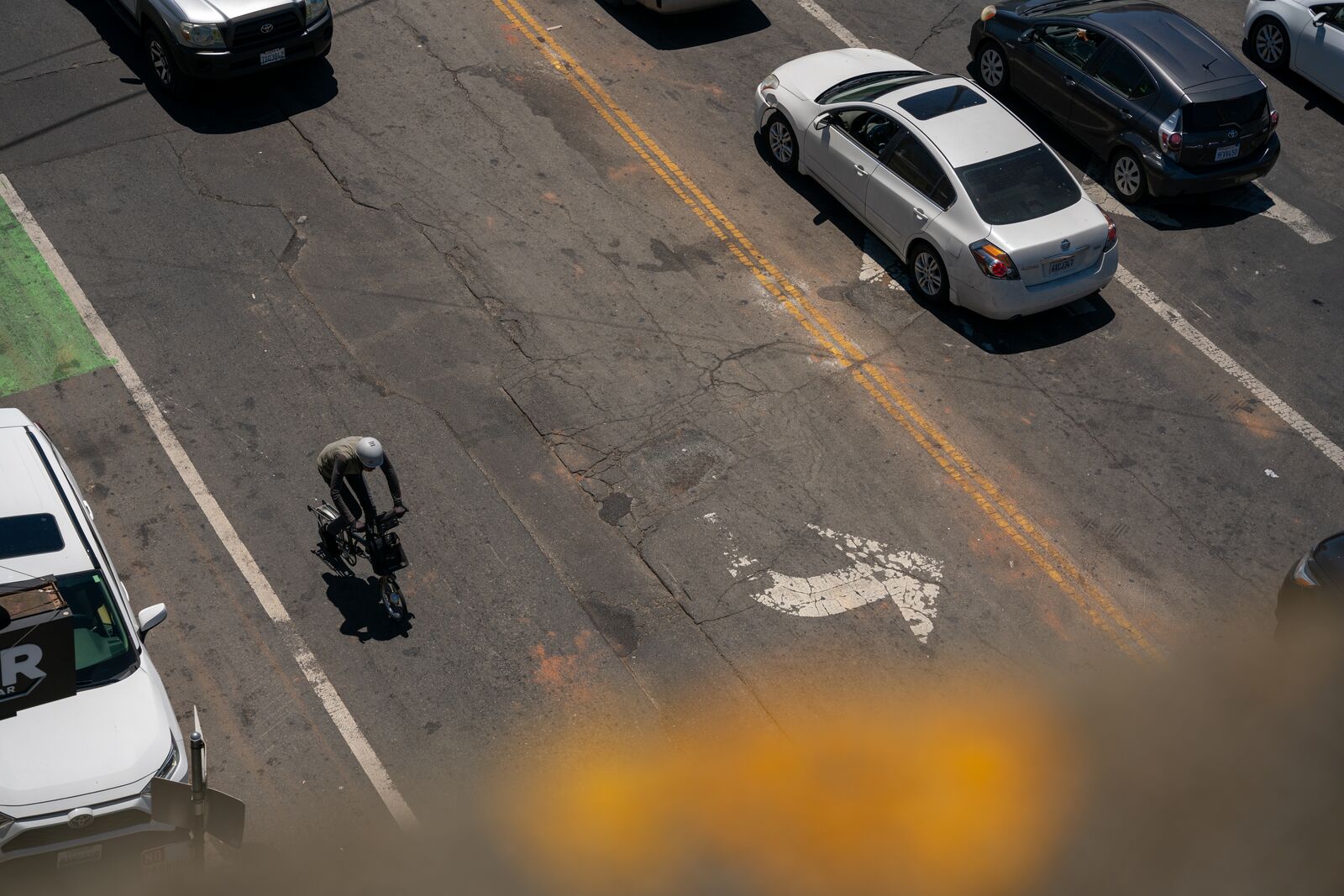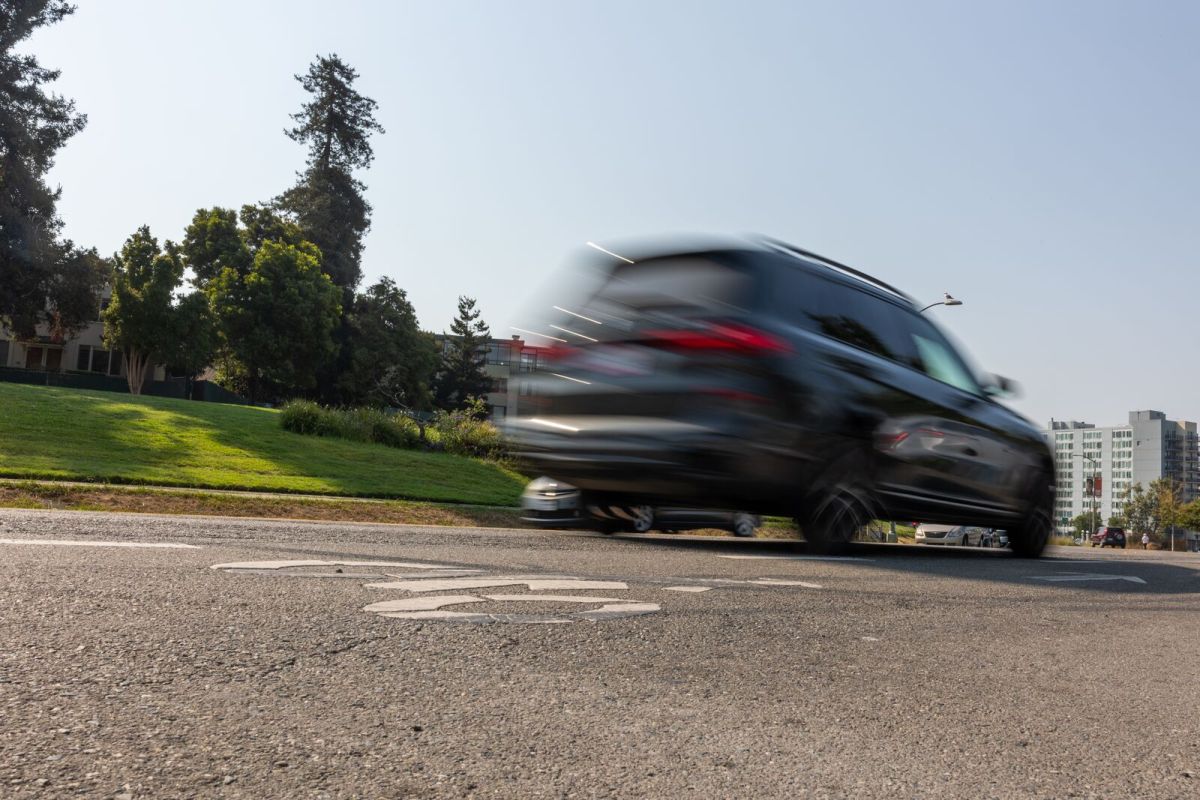California lawmakers have approved several bills that could make roads safer for pedestrians, bicyclists, and motorists in Oakland.
The year’s legislative session concluded Thursday with bills that address speeding enforcement, visibility at intersections, and a law that permits the use of bikes on sidewalks.
The bills aren’t guaranteed to become law; they still need Governor Gavin Newsom’s signature. Newsom has 30 days to accept or reject them. We’ll track what happens, but here’s more about these important proposals.
The return of automated cameras?

Between 2005 and 2014, Oakland used automated cameras to catch red-light-running drivers on several major streets, but privacy concerns and cost overruns ended this program. Assembly Bill 645 would bring similar cameras back on a pilot basis.
Authored by Glendale Assemblymember Laura Friedman, AB 645 will allow Oakland and five other cities, including San Francisco and Los Angeles, to add automated speeding cameras along the most dangerous corridors. Oakland will also be allowed to place speeding enforcement cameras near schools and at dangerous locations, such as intersections where sideshows frequently occur.
The Oakland Department of Transportation would select camera locations after a period of public outreach.
The number of cameras installed in each city would be based on population. Oakland could install, at most, 18 cameras.
People caught speeding 11 mph or more over the posted speed limit would receive $50 speeding tickets.
The law would sunset in 2032 unless extended or replaced with a new bill.
“This law would be very helpful,” Tony Dang, OakDOT’s in-house policy advisor, told The Oaklandside. There has been a real change in legislators in terms of recognizing the problem we have on our hands. We are seeing too many fatalities,”
Street safety advocates in Oakland and elsewhere said they will pay close attention to the bill’s implementation if it is signed.
Justin Hu-Nguyen, the co-executive director of Bike East Bay, told The Oaklandside his organization has not taken a position on the bill. But he said road infrastructure still needs to be redesigned and rebuilt to increase safety for everyone and enforcement cameras aren’t a panacea.
“If AB 625 is passed we will advocate for a citizens advisory committee to oversee equitable implementation in Oakland, and will be encouraging [OakDOT] staff to apply for funding via Office of Traffic Safety (OTS) grants that typically go toward Oakland police activities,” Hu-Nguyen said.
There are several aspects of the bill in place that are supposed to make it relatively equitable.
For example, the city may offer a 50-80% fine reduction if people can prove they are financially unable to pay the fine, just like they already can with other citations. There will also be an option to pay fines through community service.
Citations will also be defined as non-moving violations, which means they won’t count toward driver’s license points. The cameras will also only use digital photography to capture rear license plates and will not use video or facial recognition technology, which in theory should help prevent racial discrimination.
The privacy “guard rails” provisions added this year with the help of Newsom’s staff include a rule that all footage from cameras has to be deleted after five days if there is no violation, and deleted after 60 days if a violation was found.
Not everyone believes these safeguards are enough to prevent racial discrimination and other harms that have been shown by researchers to be part of the history of traffic enforcement in Oakland. Human Rights Watch opposes the bill because they say it will “continue and replicate racial bias.”
“In Oakland, the network of streets throughout the city where historically over 60 percent of annual severe and fatal crashes have occurred covers areas that census data indicates would have higher concentrations of BIPOC and low-income community members,” their statement to the legislature said. By setting up cameras in these areas, the city will almost guarantee that tickets are disproportionately given to Black, Latino, and Asian drivers.
Tracy Rosenberg, the director of the nonprofit community organization Oakland Privacy, also has concerns.
She told the Oaklandside that local data storage is “never as secure as it should be,” and that the likely location of the cameras in low-income communities will be a “retrogressive tax” on low-income people in neighborhoods with significant underinvestment in road infrastructure. Rosenberg says the law, combined with the lower speed limits added this year through AB 43, might lead to speed traps.
“Residents may find themselves ticketed after driving 40 mph on streets they have been driving at that speed for 10 or 20 years. That is a bit of a bait and switch,” she said.
“Daylighting” corners at intersections will eliminate parking but create more visibility

Another major bill headed to Newsom’s desk is A.B 413. It’s known in transportation policy circles as the “daylighting” law.
Daylighting refers to any change a city can make on a roadway that helps everyone—from pedestrians to drivers—see each other more easily. It can involve the removal of clutter like extra signs, poles, and other stuff, but one of the biggest daylighting techniques involves parking. In practice, the new daylighting law would prohibit car parking on corner streets within 20 feet of crosswalks. This is the length it takes to fit one large car in a parking spot curbside, so most new daylighting installations would remove one parking spot near a street corner.
In its latest operating manual, the California Department of Transportation already recommends daylighting between 20 and 24 feet. OakDOT has already been slowly incorporating this guideline on streets during road repairs. The new law could accelerate OakDOT’s removal of parking spots on street corners throughout Oakland.
Not everyone is happy about the passing of the bill. Republican Senator Janet Nguyen decried the loss of parking on Twitter. “As if finding parking isn’t already hard enough!” she exclaimed.
However many of the bill’s supporters say it helps drivers as much as cyclists and pedestrians.
“This bill provides visibility to pedestrians and drivers, most of whom don’t want a child’s death on their conscience,” said George Spies, a member of Oakland’s Traffic Violence Rapid Response group, on Twitter.
Bike East Bay’s Hu-Nguyen said daylighting will make walking and biking safer. “These standards are too often ignored by traffic engineers in favor of increased car parking availability,” he said.
Marc Vukcevich, the policy director of All Streets, a non-profit street safety advocacy organization based in Los Angeles, told The Oaklandside similar laws in East Coast cities have helped lower collisions at or near intersections.
“I think stopping cars from parking immediately in front of the crosswalk will have tremendous safety benefits for kids and just people trying to cross the street without having to peek out behind the parked car,” said Vukcevich.
Allowing bikes on sidewalks in some circumstances could improve safety
A third bill that possibly has big implications for Oaklanders is AB 825, or the “bikes on sidewalks” law.
Currently, it’s illegal to ride a bike on a sidewalk in many cities. This law will allow cyclists to use a sidewalk if there isn’t any bike lane available along the road they’re traveling. This means that more cyclists will be able to use a sidewalk, for example, outside the city’s bike network, but not on, say, Lake Merritt sidewalks, which are mostly surrounded by buffered and protected bike lanes.
Current Oakland city policy has a “blanket prohibition” for cyclists riding on the sidewalk, said OakDOT’s Dang, who noted the law has been in place to protect seniors and disabled people. Just this week, OakDOT parking and mobility Director Michael Ford told the City Council’s Public Works Committee that the city’s parking enforcement unit will ramp up enforcement on sidewalks precisely because of safety concerns.
“If this bill were to (be signed by Newsom), I would assume there would be a lot of further conversations with our senior and disabled community,” Dang said.
All Streets’ Vukcevich said the law would help young people and people of color, who are most likely to ride on the sidewalk in California to get around without having to ride on dangerous streets.
“The penalties for biking on the sidewalk are [already] minor bike infractions,” Vukcevich said. “Those infractions were disproportionately aimed at black and brown folks.”

